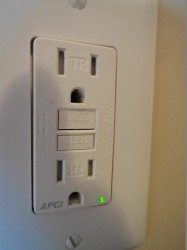The 2011 National Electric Code has an important little note at the end of section 406.4(D)(4) which just took effect January 1st, 2014. The exact text from this section is shown below:
(4) Arc-Fault Circuit-Interrupter Protection. Where a receptacle outlet is supplied by a branch circuit that requires arc-fault circuit interrupter protection as specified elsewhere in this Code, a replacement receptacle at this outlet shall be one of the following:
-
- A listed outlet branch circuit type arc-fault circuit interrupter receptacle.
- A receptacle protected by a listed outlet branch circuit type arc-fault circuit interrupter type receptacle.
- A receptacle protected by a listed combination type arc-fault circuit interrupter type circuit breaker.
This requirement becomes effective January 1, 2014.
This section requires that all replacement receptacles be arc-fault circuit interrupter (AFCI) protected. This means that if you’re replacing an old outlet in an old home in a location that needs AFCI protection in a new home, the replacement outlet needs to be AFCI protected.
What’s an AFCI device? In short, it’s an electrical safety device designed to prevent fires. It looks and acts a lot like a GFCI device in that it has a test button and a reset method, but GFCI devices are designed to prevent people from getting electrocuted, not prevent fires. For an excellent document explaining the functionality of AFCIs as well as the history of these devices, click here: AFCIs Come of Age.
 To paraphrase the exact code text, there are three ways to achieve compliance with this new requirement:
To paraphrase the exact code text, there are three ways to achieve compliance with this new requirement:
- Replace the outlet with an AFCI outlet. AFCI outlets look almost identical to GFCI outlets.
- Install an AFCI outlet upstream from the new outlet. AFCI outlets can protect outlets wired downstream from them.
- Add AFCI protection to the entire circuit, using an AFCI circuit breaker. This is fairly easy to do in modern electric panels, but it’s not possible with fuse panels and many older circuit breaker panels.
AFCI protection is currently required for all 15 and 20 amp branch circuits providing power to outlets* in residential family rooms, dining rooms, living rooms, parlors, libraries, dens, bedrooms, sunrooms, recreation rooms, closets, hallways, and similar rooms or areas. Once the 2014 NEC is adopted, both outlets and devices in these locations will need AFCI protection, and list will be expanded to include kitchens and laundry areas.
* An “outlet” is defined in the NEC as “A point on the wiring system at which current is taken to supply utilization equipment.” This might mean a light, a smoke alarm, or a ‘receptacle’. A receptacle is what normal people call an outlet.
With this new requirement now in effect, I’m guessing the demand for AFCI outlets is going to skyrocket. Home Depot sells AFCI outlets for under $30, but they currently only have white. For more info on AFCI outlets from Leviton, click here: Leviton AFCI Outlets.
Special thanks to Doug Olson at the Richfield Home Depot Pro-Desk for letting me know about this code section that just took effect.
Author: Reuben Saltzman, Structure Tech Home Inspections

Tyler
January 7, 2014, 10:43 am
Holy crap, am I reading this right? Basically, if you’re replacing an outlet (to change color, bad connection, etc) you HAVE to use an AFCI outlet??
Reuben Saltzman
January 7, 2014, 10:48 am
@Tyler – that’s correct, assuming the outlet you’re replacing is in a place that needs AFCI protection, and doesn’t already have AFCI protection. It’s a pretty significant change.
Charles Buell
January 7, 2014, 3:38 pm
Reuben, I am pretty sure this was added as a way around the problem of some panels not being able to accept an AFCI type breaker. Clearly that is the location AFCI protection should be located. But if you have a full panel or a fuse panel it would be easier to do a point of use AFCI. Of course upgrading the panel might be warranted anyway–but I guess that could in some cases mean a whole new service.
Reuben Saltzman
January 7, 2014, 4:21 pm
@Charles – I completely agree.
Dave Matheson
January 22, 2014, 4:25 am
Same sentiments with Tyler! I had to re-read it to make sure! So we must use AFCI like all the time now?
Reuben Saltzman
January 22, 2014, 5:30 am
@Dave – yes, pretty much.
Shawn Jackson
January 22, 2014, 10:30 am
I work for a radon company and we cannot install radon fans into a gf I outlet. the outlet almost invariably trips. do you think a radon fan would trip an AFCI circuit?
Charles Buell
January 22, 2014, 5:08 pm
Shawn, I would say that if the fan is tripping the AFCI, there is something wrong with the fan—not the AFCI.
Reuben Saltzman
January 23, 2014, 5:04 am
@Shawn – ditto what Charles said. Also, AFCIs are not required in attics.
Charles
January 25, 2014, 5:17 pm
Do AFCI receptacles work on circuits with shared neutrals?
Gary
March 27, 2014, 11:13 am
Is it a requirement when replacing an existing breaker panel to upgrade breakers to AFCI?
Reuben Saltzman
March 28, 2014, 3:32 am
@Gary – No. It’s a nice time to upgrade to AFCI breakers, but it’s not a requirement.